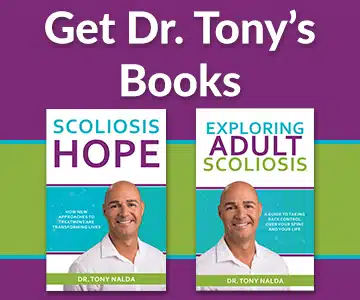As the discs of the spine don’t have their own vascular supply, treatment is somewhat limited when it comes to reversing the effects of disc herniation fully; that being said, improvements can always be worked towards, and focusing treatment efforts on the affected disc’s surroundings, as well as the disc itself, can also help increase circulation, muscle strength, and reducing nerve compression.
When it comes to herniated disc treatment, different treatments offer different results. Treatment plans can focus on pain relief, nerve compression, increasing surrounding muscle strength, disc replenishment, or an integrative approach that strives to achieve all of the above.
To better understand the treatment process for disc herniation, let’s first touch on some basic spinal anatomy, with a focus on intervertebral-disc structure and function.
Anatomy of the Spine
In a healthy spine, the vertebrae (bones of the spine) are stacked on top of one another in a straight and neutral alignment.
When the vertebrae are properly aligned, the spine’s natural and healthy curvatures are in place; when one or more of the vertebrae move out of alignment with the rest of the spine, healthy curves are lost, which disrupts the biomechanics of the entire spine.
There are three main sections of the spine, each having its own characteristic curvature type: cervical (neck), thoracic (middle/upper back), and lumbar (lower back).
While disc herniation can occur anywhere along the spine, it most commonly affects the cervical and lumbar sections.
The vertebrae are separated by the spine’s intervertebral discs, which preserve the spine’s overall health and function.
Intervertebral Discs
The intervertebral discs sit between adjacent vertebrae and consist of two main structures: the inner nucleus pulposus and the outer annulus fibrosus.
When there is a tear in the outer annulus, and part of the nucleus is pushing through, protruding into the spinal canal, this means the disc is herniated.
The inner nucleus is a soft gel-like substance containing water, collagen, and proteoglycans (PGs), and while the tough outer layer contains the same substances, the concentration of water and PGs is much higher in the inner nucleus; the PG molecules are important because they attract and retain water.
When we are born, the spinal discs are made up of 80-percent water, but as we age, that level decreases. If a disc loses a significant amount of hydration, disc desiccation can occur, which is a common aspect of degenerative disc disease (DDD).
As the vertebrae attach to the discs’ endplates, they give the spine structure. While a single vertebra doesn’t have much flexibility, a significant amount of vertebral movement (extension and flexion) can be accomplished when multiple vertebrae combine forces.
The discs also act as the spine’s shock absorbers, providing cushioning between adjacent vertebrae so they don’t rub up against one another and facilitating the absorption and even distribution of mechanical stress incurred during movement.
As mentioned, the discs don’t have their own vascular supply; in fact, they are the body’s largest structures with no vascular supply, meaning there are no direct routes into and out of the discs for transporting blood (oxygen and nutrients) and removing waste.
The way the discs stay hydrated and replenish/repair themselves is through movement, and movement also keeps the muscles that run alongside the spine strong and loose, not to mention increasing circulation in the area.
The only way the discs can absorb nutrients is through a process similar to osmosis whereby nutrients are diffused through the discs’ end plates; increasing circulation around the discs is important.
So when people ask the question, “Will my herniated disc go away?” the answer is that once a disc is damaged, partially due to the fact that the discs have no vascular supply, in terms of completely reversing that damage, treatment is somewhat limited; however, treatment options can work towards improvements by increasing circulation to the discs’ surroundings as nutrient replenishment is key to cellular repair and reproduction.
Let’s talk more about treatment options.
Herniated Disc Treatment Options
When a disc becomes herniated, this means the inner nucleus has leaked into the spinal canal through a tear in the outer annulus; when this happens, the disc’s inner gel-like nucleus and/or the disc’s outer annulus can press against the nerve roots that run alongside the spinal column.
Nerves are like branches on a tree, fanning off in multiple directions, which is why when a nerve is exposed to uneven pressure, the effects aren’t isolated to the compression site but can be felt throughout the body.
While some people with a herniated disc don’t develop noticeable symptoms like back pain and/or radicular pain felt in the legs and feet, this depends on various factors such as patient age and overall health, causation, severity, and the degree of nerve involvement.
There are different herniated disc treatment options, including medication and injections, physical therapy and exercise, chiropractic care, and surgery, so let’s start with the most common and then move on to other forms of treatment.
What is the Most Common Treatment for Herniated Discs?
When it comes to treatment for herniated discs, it’s helpful to understand that treatment plans have to be case-specific; important patient/condition variables will be the driving force behind the design of customized treatment plans.
The most common initial response is medication and injections. Medications can include anti-inflammatory agents and non-narcotic analgesics.
Medications and injections can address condition-related pain and help reduce inflammation in the area, which can help relieve pressure on affected nerves.
Usually, medications are coupled with guidance on avoiding further strain and addressing lifestyle choices that can negatively impact the discs: carrying excess weight, chronic poor posture, lifting heavy objects repeatedly with the back muscles instead of the leg muscles, and a sedentary lifestyle.
In the majority of cases, it’s natural age-related degenerative changes to the spine, occurring over time, that lead to deterioration of the intervertebral discs.
If non-invasive medications fail to make improvements, steroid injections can be recommended as they can be injected directly into the area around the affected spinal nerves for precise results, especially when guided by ultrasound.
If medication and injections have been unsuccessful, or for those who choose to forgo medications, other treatment options include physical therapy and chiropractic care.
Chiropractic Treatment for a Herniated Disc
At the Scoliosis Reduction Center®, I offer patients a conservative chiropractic-centered treatment approach that combines multiple treatment disciplines for the most customized and effective results.

While no treatment results are ever guaranteed, an integrative approach allows patients to benefit from what different treatment modalities have to offer by impacting a condition on multiple levels.
Firstly, I would address any lifestyle factors that might contribute to the deterioration of the spine because regardless of what treatment is applied, if those issues aren’t rectified, even successful treatment will only last for so long before the condition becomes more severe symptoms return.
As a chiropractor, I know the spine, how various conditions affect it, and how to improve overall spinal health and function through proactive treatment.
By conducting a comprehensive physical exam, including exploring a patient’s medical history and observing a patient’s posture and gait, I can tell a lot about the health of their spine.
I also perform orthopedic and neurological testing as part of the diagnostic and assessment process, which tells me if the reflexes are intact, the nerves are sending messages properly, if there is muscle-strength loss of muscle wasting, and whether there is muscle-strength loss of muscle wasting or not there is sensation loss along certain nerve routes.
Through X-ray or MRI, when necessary, plus the physical exam and additional testing, I can learn everything I need to know about a patient’s herniated disc in order to craft an effective and customized treatment plan.
As a spine specialist, I examine and treat the entire spine, not just the area with the herniated disc, because I want to gauge how the spine is functioning overall, and what happens in one part of the spine can affect other spinal sections and areas of the body.
Once I know the condition’s cause and important variables, I move forward with treatment. If the condition is neurological, that has to be the main focus of treatment because it is the underlying cause; if a disc injury or trauma causes the condition, that will determine the types of treatment I apply and how I apportion them.
So not that we’ve talked generally about chiropractic care for herniated discs; let’s focus on some of the specific chiropractic techniques used.
Chiropractic Techniques Used for Treating Herniated Discs

Often, spinal manipulation, commonly known as adjustments, can effectively treat a variety of spinal conditions, herniated discs included.
For example, a flexion-distraction technique is one of the most common chiropractic techniques used for addressing herniated discs; this is done by placing the patient on a specialized table that gently stretches the spine and its surrounding muscles.
Flexion-distraction allows me to isolate the affected area while gently flexing the spine through a pumping rhythm facilitated by the specialized table.
In most cases, this is a painless form of treatment that encourages a disc’s inner nucleus to return to its central position inside the disc; not only does this help move the disc away from affected nerves and reduce inflammation of the nerve roots can also improve disc height.
With the flexion-distraction technique, often, a series of treatments is needed. I often favor an integrative approach with ultrasound, muscle stimulation, supplementation, physiotherapy, and physical therapy.
Spinal manipulation under anesthesia (MUA) can also be performed to effectively stretch and manipulate the affected area more intensely while the spine and body are in a relaxed state.
Physical therapy and custom-prescribed exercises such as pelvic blocking can also be effective, particularly when it comes to increasing core muscle strength, so the spine is better supported and stabilized.
Certain exercises can also be effective at drawing a disc away from an affected nerve to reduce inflammation, compression, and related symptoms.
Physical therapy exercises can also be effective at increasing circulation to the surrounding area so that increased blood flow provides more access to important nutrients needed for cellular repair and rejuvenation, accessible to the discs only through a process of osmosis.
Surgical Treatment for Herniated Discs
While there are surgical treatment options for herniated discs, most cases respond to less-invasive forms of treatment such as medication, chiropractic care, and physical therapy.
There are a variety of surgeries that can remove the portion of the nucleus that is protruding into the spinal canal, or in severe cases, the entire disc, but this costs the spine in terms of functional mobility.
The most common surgery for herniated discs is called discectomy and involves removal of all or part of the damaged disc and a laminectomy which consists of the removal of a portion of bone that’s covering an affected nerve.
Additional surgeries include spinal fusion, cervical corpectomy, laminoplasty, laminectomy, and sometimes, multiple spinal procedures are combined for specific surgical results.
As is the case with all surgeries, there are risks involved, and when it comes to spinal surgery, the potential risks, side effects, and complications can be particularly severe.
Conclusion
When it comes to herniated disc treatment options, I always advise patients to do their research to ensure they are making an informed decision and that their treatment expectations are aligned with the reality of their potential outcomes.
When it comes to spinal surgery, these procedures are expensive, lengthy, and invasive, which is why I suggest patients try other less-invasive forms of treatment first.
Here at the Scoliosis Reduction Center®, my patients benefit from a chiropractic-centered approach that works towards condition improvements that remove the need for more invasive forms of treatment down the road.
While every case is different, my personalized treatment plans for patients with herniated discs integrate multiple treatment modalities to increase core muscle strength and circulation, adjust the spine on a structural level, return the nucleus to its central position inside the annulus, and reduce the nucleus nerve compression.





